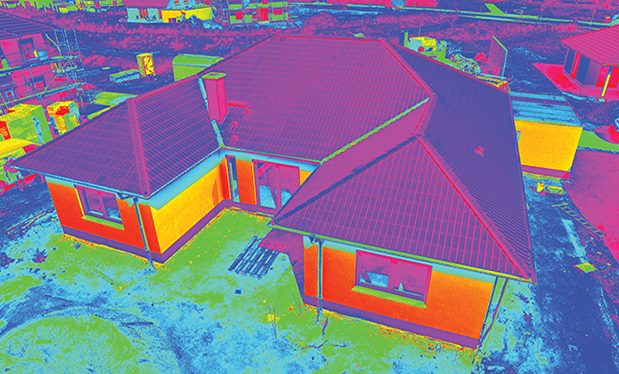In 1883, Henry Hobson Richardson designed Pittsburgh’s Allegheny County Courthouse “to express in the exterior the character and purpose of the interior and to rely for architectural effect upon the arrangement of the messes, and the dignity and solidity of the construction.”
The historical landmark was completed in 1888, but Richardson died in 1886 and did not live to see his masterpiece of Renaissance symmetry, Romanesque details, French Gothic dormer windows and French Renaissance roof systems come to reality. Among the most impressive features is the courthouse tower, rising more than 229 feet.
Although the courthouse withstood the elements for more than a century, after 130 years, it began showing signs of wear. Leaks became abundant with a clear and rising concern about the roof system.
“It was imperative that when we sought out roofing contractors to renovate the roof of our historical landmark, they would be able to replicate the look of the original courthouse tiles, work within the schedule of the county, and safely install and maneuver over a 60-degree surface efficiently,” says Alan Caponi, acting director, department of facilities management, for the county of Allegheny.
County administrators selected Cuddy Roofing Co., Pittsburgh, as the roofing contractor to complete the roofing work.
“Cuddy Roofing not only met but exceeded our criteria,” Caponi says.
Prep and tear-off
In February 2018, the Cuddy Roofing crew began work on the $10 million Allegheny County Courthouse roofing project that included a 52,200-square-foot roof system replacement while working from a 100-foot height on a 23:12 roof slope in a bustling city. The first challenge was finding a way to safely navigate workers and materials in an almost vertical slope.
To achieve this, workers were tied-off and scaffolding was built every few feet up the walls along with a pedestrian protection system to allow public access to buildings and sidewalks. The entire perimeter of the walking base of the scaffolding at the gutter line also was lined with plywood to prevent anything from falling to the street.
Workers began with repointing masonry on the courthouse’s tower and then carefully removing the original 450,000 clay roof tiles attached to steel purlins with copper wire.
“We needed to remove each tile by cutting the wires and placing each tile into a 5-gallon bucket,” says Chaz McNulty, president of Cuddy Roofing. “The transfer process included a roof-mounted ladder hoist set in a homemade trash box set on the scaffolding.”
Situated in a major business hub, it was imperative roofing work did not disrupt traffic and other city activities. Cranes could not be used to unload and load material on business days, and there was no ground staging area.
“To resolve these obstacles, we brought our own crane every Saturday for one year,” McNulty explains. “We would close the streets with police security to protect the public, remove tiles and debris, preload a week’s worth of materials and store it all high above the scaffolding so we were ready for the workweek come Monday. While doing all this, we also needed to be aware of the weight we were setting on the scaffolding based upon engineers’ calculations.”
Work schedules also had to be arranged around special events such as Pittsburgh Penguins hockey games, downtown parades and high-profile court trials inside the courthouse.
Replicating history
Project requirements mandated the new roof system look exactly like the original, so the existing ridge and hips along with decorative skirting pieces, finials and graduated tiles at the turrets were sent to Ludowici® in New Lexington, Ohio, the same manufacturer that produced the original tiles, to create custom molds.
“During fabrication of some of the larger pieces, there were cracks in the tiles that took longer to correct than anticipated,” McNulty says. “Some of the tiles also needed modifications to fit properly, which required us to cut and grind tiles in the field.”
After the existing tiles were removed, Cuddy Roofing workers inspected the purlins for visible deficiencies and rust before mechanically fastening 3/4-inch-thick fire retardant-treated plywood to the purlins with 42 self-tapping fasteners on each 4- by 8-foot sheet of plywood.
Workers then fastened a double layer of 30-pound felt followed by an application of Carlisle® 300HT® self-adhering sheet as the new underlayment.
To help facilitate project work, Cuddy Roofing workers held weekly job meetings with city officials that included daily photo documentation, time-lapsed videos of work in progress and project completion guidelines to prevent obstacles from exacerbating.
“During the first month, we ran into a few complications,” McNulty says. “Proper staging on the sloped roof had to be given extra attention. Also, the fasteners and drills were getting burned out rapidly. After we worked out these bugs, we were able to increase manpower and operate as a well-oiled machine.”
After installing new deck sheathing and underlayment, workers nailed 6- by 12-inch clay roof tiles to the substrate.
“The custom-made terracotta tiles matched exactly how the courthouse looked at its grand opening so many years ago,” McNulty says. “Decades of soot, pollution and weather had turned the tiles to a dull blackish brown. Now we see fresh, bright adobe-red tiles. The contrast between old and new is breathtakingly dynamic.”
Cuddy Roofing craftsmen then installed the custom-fabricated ridge, hips, finials and other decorative pieces.
A beacon of rejuvenation
In May 2019, the Cuddy Roofing crew successfully completed its work on Allegheny County Courthouse. Because of the difficulty fabricating some of the specialty ridge pieces, the project was delayed two months, but determination and outstanding planning and coordination demonstrated by workers resulted in a historically accurate roof system restoration of a Pittsburgh landmark that will be enjoyed by visitors from throughout the world who come to marvel at the building’s architecture.
“As Pittsburgh begins a renaissance and sheds its soot-covered past, so has the Allegheny County Courthouse,” McNulty says. “Much like the city and people, the courthouse now stands as a shining beacon of rejuvenation and hope ready for another 13 decades.”
For its exceptional work on Allegheny County Courthouse, Cuddy Roofing received a 2020 Gold Circle Awards honorable mention from the Roofing Alliance in the outstanding workmanship category.
“Cuddy Roofing navigated multiple challenges with expertise, and we are thrilled with the final product they delivered,” Caponi says.
Original tiles turned into keepsakes
Through a partnership with metalware company Wendell August Forge, Mercer, Pa., Allegheny County Courthouse’s original 450,000 clay roof tiles are being transformed into collectible keepsakes such as candle holders, wall hangings and wine trays. Proceeds from the Allegheny County Courthouse Tile Collection benefit the Allegheny County Parks Foundation, supporting the improvement, preservation and restoration of nine county parks consisting of 12,000 acres. To purchase an original keepsake, go to www.wendellaugust.com/allegheny-county-courthouse.
Project name: Allegheny County Courthouse
Project location: Pittsburgh
Project duration: February 2018–May 2019
Roof system type: Clay tile
Roofing contractor: Cuddy Roofing Co., Pittsburgh
Roofing manufacturers: Carlisle® WIP Products, Carlisle, Pa.; Ludowici,® New Lexington, Ohio



